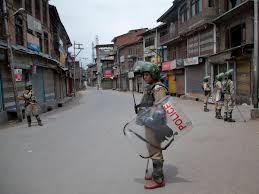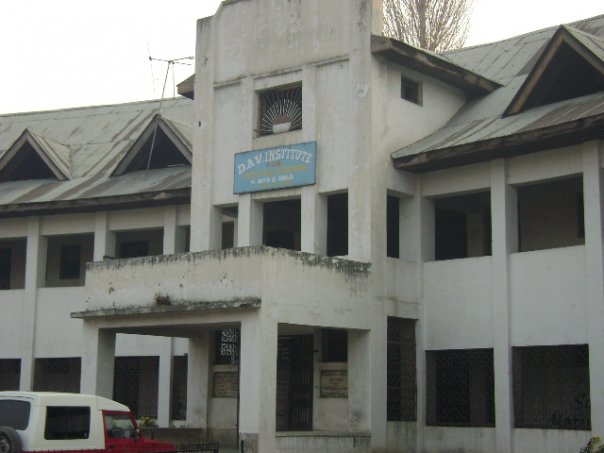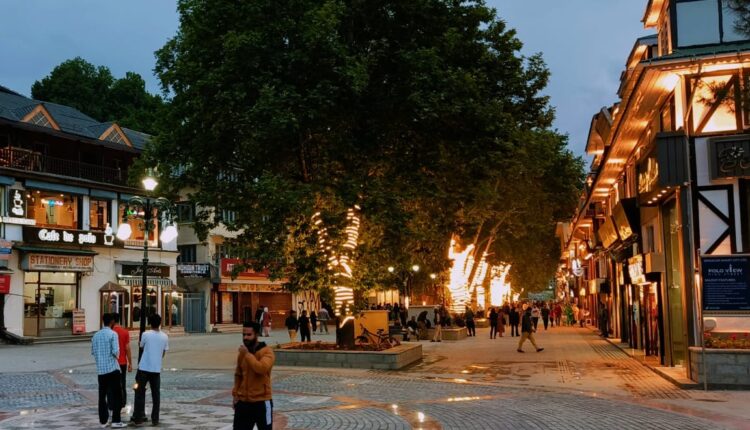 Every day, Residency Road in Srinagar is packed with thousands of shoppers, commuters, students and office goers. It is the busiest street in the heart of Srinagar city. But, these days, it takes a while before you notice a moving soul. Shops are shut, business establishments are closed and no one has any inkling when the situation will return to normal.
Every day, Residency Road in Srinagar is packed with thousands of shoppers, commuters, students and office goers. It is the busiest street in the heart of Srinagar city. But, these days, it takes a while before you notice a moving soul. Shops are shut, business establishments are closed and no one has any inkling when the situation will return to normal.
Srinagar, the summer capital of the state of Jammu and Kashmir, is a curfewed city; its days bear an uncanny resemblance to its nights. A city of more than 1.5 million people is caged and wrapped in concertina wires. And its streets are missing human existence.
The silence broken by an occasional jackboot-tapping, bamboo sticks, roaring vehicles, and the siren of ambulances ferrying the wounded. The deafening silence is the only sound in this tormented city. Some places in the city look strikingly like New York City in the Hollywood film I Am Legend — in which a virus, originally created to cure cancer, wipes out most of mankind.
“We are jailed inside our homes,” said Ali Mohammad Koka, a driver by profession, who lives on the Bund near Lal Chowk. A lane leading to Koka’s house is closed with coils of concertina wires.
But than when you move towards the clock tower, in central Lal Chowk, the Red Square — a name given to it by a leftist Sikh intellectual BPL Bedi after the Red Square of Moscow, and a place were Indian’s first prime minister Jawaharlal Nehru addressed a huge gathering in 1948 and promised Kashmiris a referendum — you find paramilitary soldiers, manning different entry and exit points, refusing to allow anyone access.
“These days,” said Ashraf Ahmad, who runs a tea stall inside a taxi stand near clock tower, “I sell tea to CRPF and police personnel, because no one else will come here”.
But Tuesday was different. A group of reporters met outside a newspaper stall, sat on the pavement, and discussed Kashmir. Most of them were meeting after a long time. But even this short accidental gathering was cut short by a policeman zooming in and ordering them to honourably disappear from the street. It took them less than four minutes to leave.
A day earlier, accompanied by a colleague, I sat on a staircase for three long hours to count the number of vehicles passing through Lambert Lane, on Residency Road, we counted three: One of the Jammu and Kashmir police, another of a journalist going to office and the third, a Jammu and Kashmir Bank van.
We walked towards Lal Chowk and saw a group of soldiers with bamboo sticks and rifles slung across their shoulders, nervous. They were from Manipur, Andhra Pradesh, West Bengal, Rajasthan, Kerala and Tamil Nadu. Striking a conversation with them was difficult.
“Don’t know when this election will get over, and we can go home,” a CRPF soldier freshly deployed in Kashmir, said causally, after checking our ID cards.
“But there’s no one around who will come for ‘matadan’ (voting),” he added, as we tried to explain that there were no elections scheduled in the near future. Was he being naïve or just kidding, I wondered as we walk towards the tower. On a normal day, you would struggle to get a space enough to even set down a foot. But these days, a CRPF bunker-style vehicle is the only visible footprint on the street.
Then there was a group of soldiers on the left side of the tower. We walked towards them, but with heavy legs. Deep inside, I wasn’t even sure if they would beat us or simply shoo us away.
As per the Hurriyat’s protest calendar — a week-long protest programme — some evenings had seen signs of life in Lal Chowk, as people rushed towards the city centre for ‘distress shopping’, mostly for the brides and grooms getting married during the curfew period. However, the hustle and bustle of the market disturbed the government, which imposed stricter restrictions especially on days that the Hurriyat asked people to open shops. Any sort of normalcy on the Hurriyat’s call is unacceptable to the government. Because, as a police officer told me, “if Syed Ali Geelani can impose a curfew, why can’t we?”
Lal Chowk, has witnessed these bouts of silence for over seven decades now. Silence in Lal Chowk reflects history — the near-silence of New Delhi when it comes to resolving the political dispute in Kashmir.
Much of Srinagar looks the same, but not the south and north of Kashmir, where people protest freely. Almost everyday, incidents of stone-pelting are reported from the region, including Srinagar’s downtown area, but not near Lal Chowk. Even the Maisuma locality — the stronghold of JKLF chairman of Yasin Malik, who is presently under detention — is silent. The paramilitary forces have closed roads leading towards the area.
On Wednesday, I crossed more than four checkpoints while travelling towards the downtown area of Srinagar, where roads were blocked by barricades and concertina wires. Fatigued soldiers looking nervously at approaching civilians, and without giving them an audience, often shooed them away. They seemed tense and angry.
In the sensitive Nowhatta area, a women peeped out of a gate before venturing out onto the road. “We are most vulnerable. Getting out of the house is a difficult. Soldiers don’t allow you to come out, and you don’t want to get trapped in a stone-pelting incident. Children are the worst sufferers and are confined to one room,” she said.
Tuesday, April 30, 2024
Breaking News
- iGen: Are Smartphones Ruining Our Youth? A Deep Dive into Haidt's 'The Anxious Generation'
- AI & Oil Rush! The Unexpected Sectors Hiring Like Crazy in India
- Ladakh Set for a Fierce Battle as Jamyang Tsering Namgyal Mulls Independent Candidacy
- Heavy Rains Cause Havoc in Kashmir, Landslides Block Srinagar-Jammu Highway
- Farooq Abdullah Accuses Rival Parties of Seeking Anantnag Poll Deferral Due to Weather Woes





